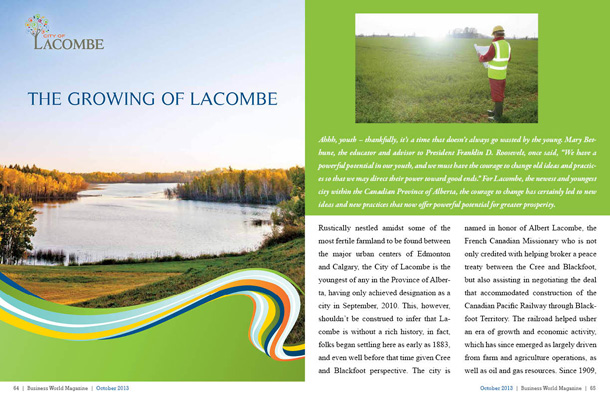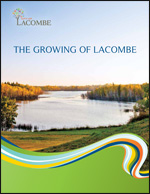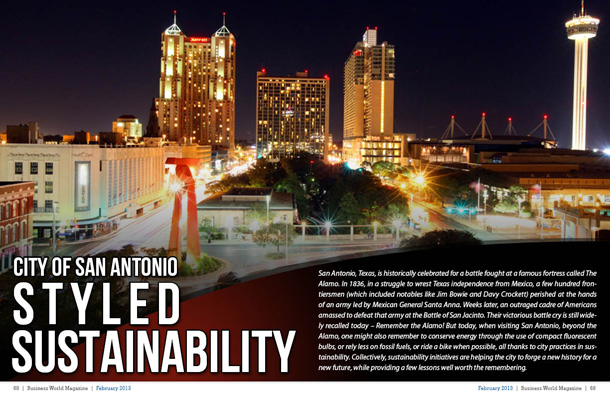
The Growing of Lacombe

Ahhh, youth – thankfully, it’s a time that doesn’t always go wasted by the young. Mary Bethune, the educator and advisor to President Franklin D. Roosevelt, once said, “We have a powerful potential in our youth, and we must have the courage to change old ideas and practices so that we may direct their power toward good ends.†For Lacombe, the newest and youngest city within the Canadian Province of Alberta, the courage to change has certainly led to new ideas and new practices that now offer powerful potential for greater prosperity.
Rustically nestled amidst some of the most fertile farmland to be found between the major urban centers of Edmonton and Calgary, the City of Lacombe is the youngest of any in the Province of Alberta, having only achieved designation as a city in September, 2010. This, however, shouldn’t be construed to infer that Lacombe is without a rich history, in fact, folks began settling here as early as 1883, and even well before that time given Cree and Blackfoot perspective. The city is named in honor of Albert Lacombe, the French Canadian Missionary who is not only credited with helping broker a peace treaty between the Cree and Blackfoot, but also assisting in negotiating the deal that accommodated construction of the Canadian Pacific Railway through Blackfoot Territory. The railroad helped usher an era of growth and economic activity, which has since emerged as largely driven from farm and agriculture operations, as well as oil and gas resources. Since 1909, Lacombe has been home to Canadian University College, a Christian institution supported by the Seventh-day Adventist Church, yet over the years, a number of public schools have emerged as part of the Wolf Creek Public School System. Other essential studies are conducted at Lacombe Research Center, a highly-respected extension of a dynamic network of crop & livestock-based research centers maintained by Agriculture and Agri-Food Canada. This center actually helped develop a variety of hog called Lacombe, the very first of livestock breeds developed in all of Canada, in this case, characteristically bred to thrive within a prairie environment. The town that was Lacombe has a fascinating history, indeed.
Today, as a city, community leaders are striving to ensure Lacombe has a sustainable future; a future that assures greater services, greater economic opportunities and ultimately, a greater quality of life.
Â
A Road to the Future
It has been said that failing to plan is planning to fail. With respect to winning advantages in Lacombe, community leaders came together three years ago to adopt a strategic plan. As Chief Administrative Officer Norma MacQuarrie explains, “Asset management was a priority focus … we looked at what would be important to Lacombe in the future and how we might achieve it … a term of planning must precede action.â€
Planning evolved to address a range of concerns, prompting a sustainability plan, downtown redevelopment plan, a master transportation plan and another in terms of culture and recreation. There has been a comprehensive analysis of current community assets and needs for the future, yet as Lacombe Mayor Steve Christie says, “We’ve taken some flak from some who say we’re doing nothing but studies and plans, but this has been necessary to set the stage for implementation in the future … as we continue to improve our infrastructure, improve our roads, and improve our downtown, we want to make sure through all of this we’re being sustainable.â€
That planning has already produced tangible results, of which the most visible may be completion of work upgrade and expand Highway 2A which runs right through the city center and intersects with Hwy 12, both are vital corridors of transportation. As a town, Lacombe had often battled with Provincial authorities about the need to upgrade this roadway, a decades-long affair that involved its competing with other communities who had their own respective infrastructural needs and wants in terms of securing funding from Provincial coffers. Lacombe was more or less impacted by whatever determinations were made by the Province. In earning designation as a city, there was a contingency in that Lacombe would have to assume responsibility for the work (and the costs) involving Highway 2A, but that is exactly what they did. Lacombe actually assumed 17% of the costs involved, but total management responsibility for what Mayor Christie calls “the single largest project that has ever taken place in Lacombe.†To put that in perspective, from a two-lane town road, Hwy 2A has been transformed to include four kilometers of four-lane highway with the complement of turning lanes and network of sidewalks for pedestrians, essentially providing an attractive, accessible thoroughfare through downtown Lacombe which not only benefits existing residents and businesses alike, but increased opportunity for new business to be developed along this corridor. Better yet, Lancombe will now make the determinations about how businesses develop along this roadway without having to seek provincial permission. More remarkably, under the city’s management, the improvements to Hwy 2A were completed some $1.5 million under budget. As Mayor Christie says, “That’s an achievement which makes me especially proud as a Mayor … to know that we have a staff who works efficiently and effectively to make sure we’re being good stewards of the money we collect in taxes.â€
Both Christie and MacQuarrie view the road enhancements as vital to strategies resulting in the revitalization of Lacombe’s downtown district.
Â
Community Collaboration
There have been other enhancements which beneficially impact area residents. To put that in perspective, Director of Infrastructure Matt Goudy explains that in 2011, Lacombe endured a rare onslaught from major storm systems which led to widespread flooding. The city’s storm water management infrastructure simply couldn’t keep pace with the extensive runoff and numerous residents suffered in the process. To determine means of overcoming these problems, MacQuarrie says the city began with a series of public meeting, a process that prompted another kind of flood in terms of expressions of frustration. “Residents came to us in a public meeting and they vented … they were very angry, but they told us exactly how the water was impacting them, and we were able to take this information to engineers, so they could better understand the problems and build solutions into a new storm water model,†says MacQuarrie.
Goudy explains that a site specific approach was deployed, which included laying of new, larger piping systems directly beside the old pipe, which remained in service to prevent further injury to residents already impacted. When the new system was finally installed, it was combined to the old through a network of cross connections, dramatically increasing the capacity of the overall system. “We’ve seen a major improvement in storm water retention and transmission as a result of this work,†says Mayor Christie. The system has demonstrated improvements in flood protection. There have been several storms which have struck Lacombe since that time, but the system has proven to function absent of the impacts which once occurred.
Lacombe is additionally working with the neighboring communities of Blackfalds and Red Deer on a project leading to the realization of a regional waste water system. MacQuarrie explains that, in terms of waste water, Lacombe is presently served by a lagoon site, but under the new plan, waste water will be treated in Red Deer. “It is an optimal treatment process … sending the water to Red Deer will offer a preferred treatment standard over what we presently have in place.â€
Christie says the same regional collaboration is helping in the creation of other storm water management solutions, which includes development of a comprehensive watershed management plan. “Our goal is to ensure development in the future doesn’t come with expense to our resources, homeowners, or decreased protection from flooding,†he says. “Communities battle for provincial funding, so it makes perfect sense to collaborate with other communities … we can use the funds together which is a more efficient way to spend tax dollars.â€
Such regional cooperation has also led to the creation of a public transportation system, especially significant since Grey Hound recently discontinued its service in this corridor. Through an arrangement with Red Deer, a bus service will extend from there through to Blackfalds and Lacombe, helping seniors transit to necessary appointments and more. Christie says other initiatives involve working with large employers in the area, devising a system that will allow employees to keep their personal cars at home and commute to work on this bus system.
Enhancements to the highway, public transportation, storm water management and waste water systems are still just a fraction of the advancement underway in Lacombe, yet collectively, these improvements help reflect the changes that are taking place and the intent to ensure a sustainable tomorrow. “Anyone who assumes leadership in a community becomes very aware of what you have to work with … you inherit systems that are there and try to determine what you can do with what you have,†says Mayor Christie. “We’ve been fortunate to have a council that has looked beyond our time, to the future. All of us are looking at how we can do things better. We don’t approach it as throwing good money after bad, but consider it as investing in the future of our Lacombe.â€
Â
More to Come
Lacombe has a population of almost 12,000 people, but data indicates three percent annual growth. City leaders are working yet on other initiatives to manage that growth while also improve on assets essential to existing residents. Other plans underway include increasing the capacity of the city’s primary cemetery. MacQuarrie explains that the site is very near capacity, and the grounds needed to increase space are currently occupied by baseball diamonds. Lacombe has worked out a deal which will relocate the diamonds to another site, creating a recreational cluster she says will be optimized for better hosting of tournaments in one strategic location. The master plan for the cemetery will accommodate new walking paths and landscaping to impart greater aesthetic value. This work will be completed in phases to mitigate impact.
Other plans are coming to fruition in solid waste management. MacQuarrie says this is anticipated to result in increased recycling as homeowners will be provided with receptacles thereby eliminating the need to venture to a central depot which will continue to collect materials. She says enhancing the level of recycling will lead to decreases in the amount of waste directed to the area landfill.
Another plan, a first of its kind in Alberta, will see Lacombe benefit more directly from energy usage. To put that in context, MacQuarrie explains that when residents and business alike pay their utility bills, the provider collects those fees and the money is directed out of the community. Under the auspices of a new model, the city will establish what MacQuarrie calls “an electricity retail arm.†The city is incorporating what will be known as “Echo Energy†whose function will involve marketing and customer acquisition. The City partnered with Utilitynet who will provide backend operations including the billing and processing of accounts. Utility fees will be competitive, but to add to the advantages, a portion of the proceeds will be directed into a Lacombe community development account, creating a new revenue stream to further support capital improvement projects. MacQuarrie says Lacombe will be the first municipality in the Province to enact and benefit from this kind of utility model.
Other benefits are anticipated in terms of economic development. MacQuarrie says Lacombe has met with principals of a new bio-refining company whose development in Lacombe is anticipated to generate buzz as a new green energy solution in the manufacturing of fertilizer. Christie also notes that the city has acquired land to develop 15 industrial-zoned lots, sized from 1 to 1.5 acres. He says the city has been fielding interests from new business interested in locating to Lacombe and he expects that trend to continue.
The work continues in Lacombe, but as Christie asserts, the focus on meeting the needs of today is matched with meeting needs tomorrow. Enhanced infrastructure and increased economic development will continue to evolve, begging consideration of a lament often expressed as to how soon youth so quickly fades. With respect to this three year old city, the transition to maturity is being marvelously met with greater possibilities for a growing future.
For more information, please visit their website at: Â Â City of Lacombe
Preferred Vendors of Choice:








